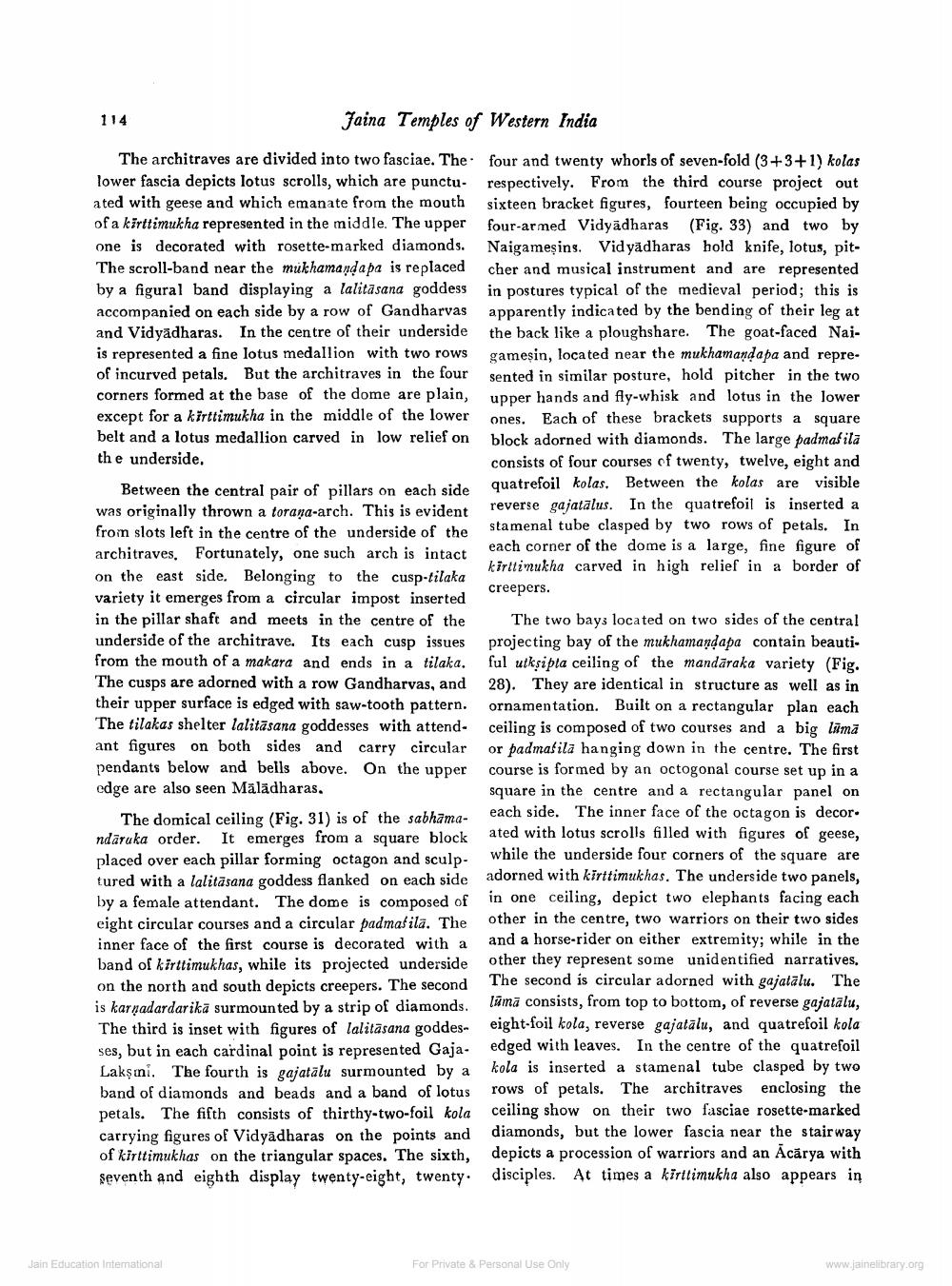________________
114
Faina Temples of Western India
The architraves are divided into two fasciae. The four and twenty whorls of seven-fold (3+3+1) kolas lower fascia depicts lotus scrolls, which are punctu- respectively. From the third course project out ated with geese and which emanate from the mouth sixteen bracket figures, fourteen being occupied by of a kirttimukha represented in the middle. The upper four-armed Vidyadharas (Fig. 33) and two by one is decorated with rosette-marked diamonds. Naigameşins. Vidyadharas hold knife, lotus, pitThe scroll-band near the mukhamanda pa is replaced cher and musical instrument and are represented by a figural band displaying a lalitasana goddess in postures typical of the medieval period; this is accompanied on each side by a row of Gandharvas apparently indicated by the bending of their leg at and Vidyadharas. In the centre of their underside the back like a ploughshare. The goat-faced Naiis represented a fine lotus medallion with two rows gamesin, located near the mukhamanda pa and repre. of incurved petals. But the architraves in the four sented in similar posture, hold pitcher in the two corners formed at the base of the dome are plain, upper hands and fly-whisk and lotus in the lower except for a kirttimukha in the middle of the lower ones. Each of these brackets supports a square belt and a lotus medallion carved in low relief on block adorned with diamonds. The large padmašila the underside.
consists of four courses of twenty, twelve, eight and Between the central pair of pillars on each side
quatrefoil kolas. Between the kolas are visible was originally thrown a torana-arch. This is evident
reverse gajatalus. In the quatrefoil is inserted a from slots left in the centre of the underside of the
stamenal tube clasped by two rows of petals. In
each corner of the dome is a large, fine figure of architraves. Fortunately, one such arch is intact
kirltimukha carved in high relief in a border of on the east side. Belonging to the cusp-tilaka variety it emerges from a circular impost inserted
creepers. in the pillar shaft and meets in the centre of the The two bays located on two sides of the central underside of the architrave. Its each cusp issues projecting bay of the mukhamandapa contain beautifrom the mouth of a makara and ends in a tilaka. ful utkşipla ceiling of the mandāraka variety (Fig. The cusps are adorned with a row Gandharvas, and 28). They are identical in structure as well as in their upper surface is edged with saw-tooth pattern. ornamentation. Built on a rectangular plan each The tilakas shelter lalitāsana goddesses with attend. ceiling is composed of two courses and a big lumā ant figures on both sides and carry circular or padmafila hanging down in the centre. The first pendants below and bells above. On the upper course is formed by an octogonal course set up in a edge are also seen Mälādharas,
square in the centre and a rectangular panel on The domical ceiling (Fig. 31) is of the sabhāma- each side. The inner face of the octagon is decor. ndāruka order. It emerges from a square block ated with lotus scrolls filled with figures of geese, placed over each pillar forming octagon and sculp- while the underside four corners of the square are tured with a lalitāsana goddess flanked on each side adorned with kirttimukhas. The underside two panels, by a female attendant. The dome is composed of in one ceiling, depict two elephants facing each eight circular courses and a circular padmašila. The other in the centre, two warriors on their two sides inner face of the first course is decorated with a and a horse-rider on either extremity; while in the band of kirttimukhas, while its projected underside other they represent some unidentified narratives, on the north and south depicts creepers. The second The second is circular adorned with gajatalu. The is karnadardarika surmounted by a strip of diamonds.
lūmā consists, from top to bottom, of reverse gajatalu, The third is inset with figures of lalitasana goddes eight-foil kola, reverse gajatālu, and quatrefoil kola ses, but in each cardinal point is represented Gaja edged with leaves. In the centre of the quatrefoil Lakşini. The fourth is gajatālu surmounted by a kola is inserted a stamenal tube clasped by two band of diamonds and beads and a band of lotus rows of petals. The architraves enclosing the petals. The fifth consists of thirthy-two-foil kola ceiling show on their two fasciae rosette-marked carrying figures of Vidyadharas on the points and diamonds, but the lower fascia near the stairway of kirttimukhas on the triangular spaces. The sixth, depicts a procession of warriors and an Acărya with seventh and eighth display twenty-eight, twenty. disciples. At times a kiritimukha also appears in
Jain Education International
For Private & Personal use only
www.jainelibrary.org




